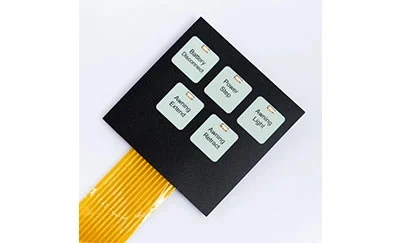
Membrane switches are an essential component in many electronic devices, providing a user-friendly interface for controlling various functions. However, like any other electronic component, membrane switches are prone to issues that can lead to downtime and disrupt operations. In this article, we will explore common membrane switch issues and provide practical troubleshooting tips to avoid downtime effectively.
Before delving into troubleshooting techniques, let's understand what membrane switches are. A membrane switch is a low-profile, flexible electronic switch that consists of several layers, including a membrane circuit, graphic overlay, and adhesive spacer layers. (Membrane Switch Design Guide)These switches are commonly used in industries such as medical devices, industrial equipment, and consumer electronics due to their durability and cost-effectiveness.

One of the most common issues with membrane switches is physical damage. This can occur due to mishandling, excessive force, or exposure to harsh environments. Physical damage may manifest as torn or punctured overlays, cracked circuitry, or delamination of layers.
Electrical malfunction is another prevalent issue that can affect membrane switches. This may include issues such as intermittent or non-responsive keys, erratic behavior, or short circuits. Electrical malfunctions can arise from damaged circuitry, faulty connections, or component degradation over time.
Environmental factors such as temperature fluctuations, moisture, dust, and chemical exposure can also impact the performance of membrane switches. These factors can lead to corrosion, oxidation, or contamination of the switch components, resulting in malfunction or failure.
More details about membrane switch repair
Begin troubleshooting physical damage by visually inspecting the membrane switch for any signs of wear, tear, or damage. Look for cracks, tears, or punctures in the overlay, as well as any visible damage to the circuitry or layers.
Use a multimeter to test the continuity of the circuitry and ensure that electrical connections are intact. Check for any open or short circuits that may be causing the issue. Pay close attention to areas where the overlay is damaged or where components are exposed.
If physical damage is identified, take appropriate measures to repair or replace the damaged parts. This may involve patching tears or punctures in the overlay, repairing damaged circuit traces, or replacing malfunctioning components. Be sure to use compatible materials and follow proper repair procedures.
Start troubleshooting electrical malfunctions by checking the power source and ensuring that the switch is receiving adequate voltage and current. Verify that the power supply is functioning correctly and that there are no issues with wiring or connections.
Use a multimeter or continuity tester to test the continuity of the circuitry and identify any faults or disruptions. Check for loose connections, damaged traces, or faulty components that may be causing the issue. Pay attention to areas where the circuitry may be exposed to moisture or contaminants.
If the membrane switch has adjustable settings or parameters, such as sensitivity or debounce time, consider re-calibrating these settings to optimize performance. Consult the manufacturer's documentation or technical support for guidance on adjusting the settings properly.
Maintain proper temperature and humidity levels in the environment where the membrane switch is installed to prevent damage from moisture or condensation. Use climate control systems or protective enclosures to regulate environmental conditions effectively.
Apply protective coatings or sealants to the membrane switch to shield it from moisture, dust, and other contaminants. Ensure that all openings, seams, and edges are properly sealed to prevent ingress of foreign materials.
Implement a regular maintenance schedule to inspect, clean, and maintain the membrane switch and its surrounding environment. Remove any debris, dust, or buildup that may accumulate on the switch surface, and check for any signs of wear or deterioration.
Effective troubleshooting of membrane switch issues is crucial for minimizing downtime and ensuring uninterrupted operation of electronic devices. By promptly identifying and addressing issues, businesses can avoid costly repairs, production delays, and customer dissatisfaction.
In conclusion, membrane switches are prone to various issues that can disrupt their functionality and lead to downtime. By understanding common issues such as physical damage, electrical malfunction, and environmental factors, and implementing proactive troubleshooting and preventive measures, businesses can minimize downtime and maximize the reliability of their electronic devices.
Q: Can I repair a membrane switch myself, or do I need professional assistance?
A: While minor membrane switch panel repair such as patching small tears or cleaning the switch can be done DIY, complex issues may require professional expertise.
Q: How often should I perform maintenance on my membrane switch?
A: It's recommended to perform regular maintenance at least once every six months to ensure optimal performance and longevity.
Q: Are there any specific cleaning agents I should avoid when cleaning a membrane switch?
A: Avoid using harsh chemicals or abrasive cleaners, as they can damage the overlay and circuitry. Use a mild detergent solution and a soft cloth instead.
Q: Can environmental factors such as extreme temperatures affect the lifespan of a membrane switch?
A: Yes, exposure to extreme temperatures can cause degradation of materials and lead to premature failure of the switch.
Q: Is it possible to retrofit existing membrane switches with additional protective measures?
A: Yes, there are various retrofitting options available, such as applying protective films or coatings, to enhance the durability and longevity of membrane switches.